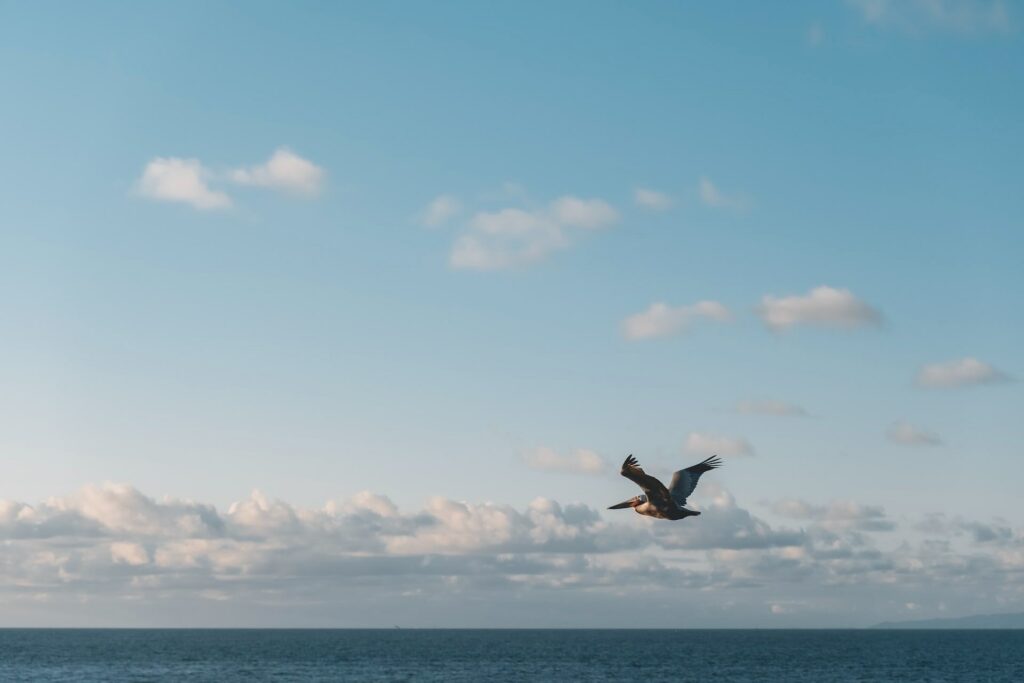Destacado en este post
San Diego, California
Aventura de avistamiento de ballenas y delfines en San Diego
Más información
Sigue explorando
San Diego, California
Esencial San Diego
Más información
You can see some amazing seabirds on our City Cruises Whale Watch cruise in San Diego, the most common of which can be found here. Here are some other, less common seabirds, including several species of herons, that can be found in San Diego Bay.
Reddish egret (Egretta rufescens)
The reddish egret is a fairly large heron with a gray body, a reddish neck, and bluish-black gray legs. Its bill is mostly pink and tipped with black. This active egret searches for food in shallow, saltwater habitats and often runs and hops to catch fish with its wings spread out. San Diego is near the northern part of the range for this species on the Pacific Coast.
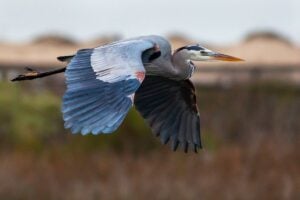
Garza azul pequeña (Egretta caerulea)
La garceta azul es una pequeña garza con el cuerpo gris azulado y la cabeza y el cuello de color púrpura a rojizo oscuro. Los juveniles son mayoritariamente blancos con las plumas de las alas de color gris claro. Cuando caza peces y ranas en hábitats poco profundos de agua dulce o salada, la garcita azul se queda quieta en aguas poco profundas y espera a que la presa potencial nade cerca.
Garza tricolor (Egretta tricolor)
Esta garza de tamaño medio es mayoritariamente gris oscura con el vientre blanco y plumas rojizas en el cuello y la espalda. El joven tiene una línea blanca que le recorre la garganta. Cuando busca comida, se queda de pie y espera a que los peces pasen nadando, o camina para remover el fondo con una pata para asustar a las presas.
Green heron (Butorides virescens)
This small, beautifully-colored heron typically rests in a crouched position at the water’s edge often hidden within vegetation. It has a greenish back with a chestnut neck, face, and chest, white streaks on each cheek and throat, dark gray wings, a gray and yellow bill, and yellow legs. The green heron usually sits at the water’s edge and waits for fish and frogs to move by, then spears them with its dagger-like bill.
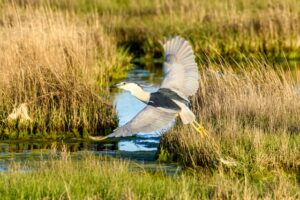
Black-crowned night heron (Nycticorax nycticorax)
The black-crowned night heron is fairly stocky with relatively short yellow legs. The plumage is dark gray from the top of its head to the back, with light-gray wing feathers, and white from the face to the belly. It also has a white patch extending from the base of the upper bill to above the red eyes. Juveniles are mottled brown and white. As its name implies, the black-crowned night heron feeds from dusk until dawn, searching for insects, worms, fishes, amphibians, and other small land and aquatic animals.
Brandt’s cormorant (Phalacrocorax penicillatus)
The Brandt’s cormorant is an iridescent black seabird found in saltwater habitats along the Pacific Coast of North America. Adults have a pale patch at the base of the throat, a bright blue throat pouch, and fine, white plume feathers on their head, neck, and back during the nesting season. During the non-breeding season, adults are much duller in color while juveniles are also a much duller brownish-black. Cormorants swim at the surface and then dive to catch fish or squid, using their webbed feet to actively swim after prey. Like other cormorants, the Brandt’s cormorant holds its wings out to dry after diving.
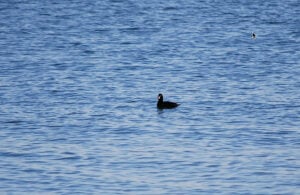
Surf scoter (Melanitta perspicillata)
This sea duck is strikingly patterned in black-and-white. The male is all black with a white forehead patch and a white patch on the back of his neck, and a white, orange, and black patterned bill. The female is a lighter brownish-black with white patches on each side of the head and at the base of the mostly dark gray bill. Nesting takes place during summer in freshwater lakes in high-elevation forests and the tundra mainly in Alaska and Canada. Surf scoters can be found in winter along both coasts of North America where it can often be seen diving for mollusks, crustaceans, and other aquatic invertebrates.
Pacific brant (Branta bernicla)
This small sea goose has a black head, neck, and chest with a broken white “collar” in the upper neck region, a brownish back, a black to light gray belly, and a white rump. The Brant nests in the Arctic on the tundra and spends winters feeding on eelgrass, sea lettuce, and other aquatic plants along both coasts of North America. The Pacific subspecies of brant winters from British Columbia to Baja California, Mexico, and can often be seen swimming and feeding in flocks during the late fall to early spring months in San Diego Bay.
Western grebe (Aechmophorus occidentalis)
The western grebe is a black and white grebe with a long neck, a spear-like yellow bill, and red eyes. This species has a black back with black extending along the back of its neck and a black cap that extends below the eyes. The almost identical Clark’s grebe can be distinguished from the western grebe by its white face (its black cap does not extend below the eyes). Western grebes nest on freshwater lakes and marshes and overwinter in bays, estuaries, and sheltered coasts. They dive to catch fish and occasionally crustaceans and aquatic worms. In the summer nesting grounds, adults perform an elaborate courtship display by rushing across the water with their necks extended.
Pied-billed grebe (Podilymbus podiceps)
The pied-billed grebe is a small, stocky, brown, bird with a short wedge-shaped bill, a brown body, and an extremely short tail. Their bill is marked with a vertical black stripe in the summer giving rise to their common name. Pied-billed grebes dive to hunt small fishes, crustaceans, insects, amphibians, and other small aquatic animals in freshwater lakes, rivers, marshes, and saltwater estuaries and bays.
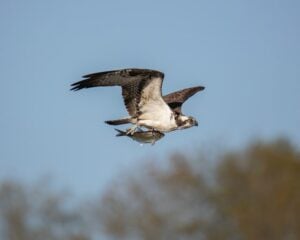
Osprey (Pandion haliaetus)
The Osprey is a common fish-eating hawk spotted in freshwater and saltwater habitats worldwide except in Antarctica. These attractive birds of prey are black to brown and white and have hooked bills and yellow eyes. They have a reversible outer toe on each foot and barbed pads on the soles that let them catch and easily grasp slippery fish. Osprey pairs build huge nests of sticks and other vegetation that are added to each nesting season and used from year to year. Often these nests are built on sea stacks, dried tree snags, and even man-made structures such as light towers, utility poles, and artificial platforms. Some of these nests are decades old and can be 10 to 13 feet tall and 3 to 6 feet across.
Pelícano pardo(Pelecanus occidentalis )
El pelícano pardo es el mayor pelícano de Norteamérica. Estas grandes aves tienen un aspecto característico de espalda jorobada, cuellos largos y picos grandes con una bolsa en la garganta utilizada para recoger peces. Los pelícanos son en su mayoría de color marrón oscuro, con un poco de marrón grisáceo más claro en las alas y el cuello. Pueden encontrarse en zonas costeras de gran parte de Norteamérica, donde se alimentan casi exclusivamente de pequeños peces que capturan lanzándose desde el aire al agua. Se reproducen en las costas desde Virginia hasta Texas y California y en el interior de los Grandes Lagos.
Pelícano blanco americano(Pelecanus erythrorhynchos)
The American white pelican is one of the largest North American birds, with a wingspan reaching almost 10 feet. They are all white with black wingtips and have a long bill with a large throat pouch used for scooping up fish. Pelicans feed cooperatively, swimming in groups to herd and trap small fishes in shallow water where they can be easily caught. These big birds breed along inland lakes in western Canada and the northern United States and spend winters along coasts from California to Texas.
Cormorán pelágico(Phalacrocorax pelagicus)
El cormorán pelágico es una especie de cormorán que se reproduce en regiones de mar abierto de todo el mundo. Esta ave es completamente negra, con un pico largo y ganchudo y patas palmeadas. El cormorán pelágico es un excelente nadador y puede sumergirse a profundidades de más de 150 pies en busca de peces. Estas aves suelen anidar en los acantilados o en los árboles cercanos a las masas de agua. El cormorán pelágico es una criatura social y suele formar grandes colonias con otras aves. Sin embargo, esta especie no está exenta de depredadores; gaviotas, águilas y otras aves de presa suelen atacar a los cormoranes pelágicos.

Cormorán de doble cresta(Phalacrocorax auritus)
El cormorán de doble cresta es un ave acuática de gran tamaño con un cuello largo y un pico ganchudo. Se encuentra en hábitats de agua dulce y salada en gran parte de Norteamérica. El cormorán de doble cresta es un excelente nadador y buceador y se alimenta de peces, cangrejos de río y otros animales acuáticos. El plumaje oscuro del ave le ayuda a camuflarse de los depredadores, y sus patas palmeadas le ayudan a remar rápidamente por el agua. El cormorán de doble cresta es una especie protegida y su número ha aumentado en los últimos años. Sin embargo, el hábito de este pájaro de anidar en estructuras hechas por el hombre, como tendidos eléctricos y barcos, ha causado algunos conflictos con los humanos.
Paloma brava(Columba livia)
La paloma bravía es una especie de paloma originaria de Europa, Asia y África. También es el ave más común en las ciudades. La paloma bravía es un ave de tamaño medio con un cuerpo rollizo y patas cortas. Su plumaje suele ser gris o azul, pero también puede ser blanco, marrón o negro. Tiene una cabeza pequeña con un pico puntiagudo. Las palomas bravas suelen vivir en bandos y a menudo se las ve buscando comida en las zonas urbanas. También son conocidas por sus vocalizaciones de arrullo. La paloma bravía es una especie importante tanto en la naturaleza como en cautividad. Se utiliza a menudo en la investigación debido a su capacidad de adaptación a diferentes entornos. La paloma bravía también se ha introducido en muchas partes del mundo, donde se ha establecido como especie molesta.
Conclusión
Si quiere ver algunas de las aves marinas menos comunes en la Bahía de San Diego, asegúrese de consultar nuestra lista. Aunque se pueden ver muchas más especies, creemos que estas quince le darán una buena muestra de lo que hay. ¿Ha visto alguna de estas aves en sus viajes por la bahía? Háganoslo saber en los comentarios.
Destacado en este post
San Diego, California
Aventura de avistamiento de ballenas y delfines en San Diego
Más información
Sigue explorando
San Diego, California
Esencial San Diego
Más información


